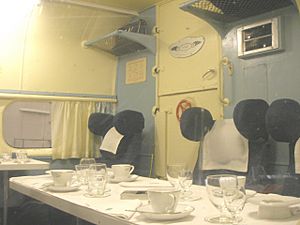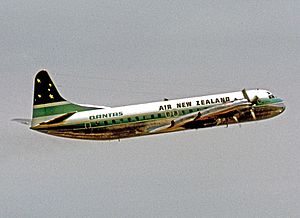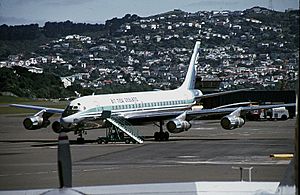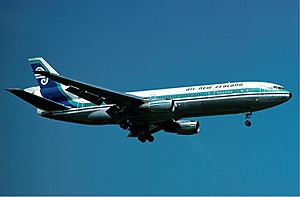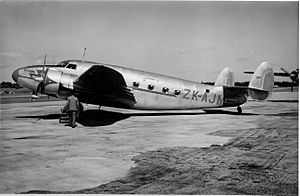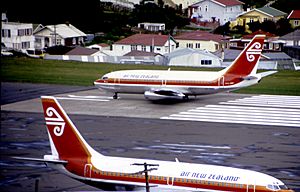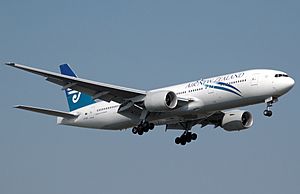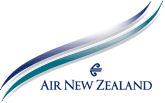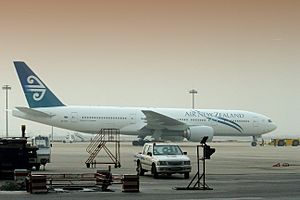History of Air New Zealand facts for kids
The story of Air New Zealand, New Zealand's main airline, began in January 1936. Two smaller airlines, East Coast Airways and Cook Strait Airways, joined together to form Union Airways of New Zealand. This was New Zealand's very first big airline.
Union Airways was the only New Zealand airline involved in Tasman Empire Airways Limited (TEAL). TEAL made its first flight in 1940. In 1961, the New Zealand Government bought TEAL completely. The airline was then renamed Air New Zealand in 1965.
Later, in 1978, New Zealand's domestic airline, National Airways Corporation (NAC), joined with Air New Zealand. Air New Zealand became a private company in 1989. However, in 2001, the New Zealand Government bought 80% of the airline. This happened after Air New Zealand faced money problems, and the government invested $885 million to help. In November 2013, the government sold some of its shares, reducing its ownership from 73% to 53%.
Contents
Early Days: Tasman Empire Airways Limited (TEAL)
TEAL was created on April 26, 1940. Its very first flight was on April 30, 1940. A Short Empire flying boat named Aotearoa carried ten passengers from Auckland to Sydney. The trip took about 7 hours and 30 minutes to cover 1345 miles.
TEAL's first report in 1941 showed great success. They had completed 130 flights across the Tasman Sea. They flew 174,200 miles and carried 1461 passengers. The airline even made a profit of NZ£31,479. During WW2, TEAL helped with the war effort. They flew special trips to places like New Caledonia, Fiji, Tonga, Samoa, and Hawaii. By June 1944, TEAL had crossed the Tasman Sea 1000 times!
After World War II, TEAL updated its planes. They first used Short Sandringham and then Short Solent flying boats. A former RNZAF PBY Catalina was also used for survey flights. TEAL started with two weekly flights from Auckland to Sydney. Soon, they added flights from Wellington and also to Fiji.
In 1953, the Australian Government bought half of TEAL. The New Zealand Government bought the other half. In 1954, TEAL added Douglas DC-6 planes to its fleet. These planes replaced the older flying boats on most international routes. Flying boat services stopped in 1960 when Tahiti's airport opened. TEAL also took over flights between Auckland and Fiji. In 1955, TEAL made its 10,000th trip across the Tasman Sea.
In 1959, TEAL changed its planes again. They replaced the DC-6s with Lockheed L-188 Electra IIs. These turboprop planes could carry 71 passengers. They flew at nearly 400 miles per hour. This cut the Auckland to Sydney flight time to 3 hours and 50 minutes.
In 1961, the New Zealand Government bought Australia's half share. On April 1, 1965, the airline was officially renamed Air New Zealand.
The Jet Age Begins
Introducing the DC-8
On September 23, 1963, Air New Zealand decided to buy three DC-8-52 jet airliners. The first DC-8 arrived in Auckland on July 20, 1965. This was also when Air New Zealand's new jet base opened at the airport. The other two DC-8s arrived in August and September. The first jet flight was from Christchurch to Sydney on October 3.
These new jets could fly much further. This allowed Air New Zealand to start flights to the United States and Asia for the first time. On December 14, the first flight from Auckland to Los Angeles took off. It stopped in Nadi and Honolulu. Flights from Auckland to Hong Kong (via Manila and Singapore) began in early 1966. A service to Tokyo (via Nadi) started in 1980.
In 1968, two more DC-8-52s were ordered. They arrived in January and February 1968. These planes had stronger engines. A sixth DC-8 was rented from United Airlines in November 1970 and bought in July 1971. A seventh and final DC-8 was also bought from United Airlines in October 1971.
The DC-10 Era
Air New Zealand ordered eight DC-10-30 planes. The first one arrived on January 27, 1973. The DC-10s brought a new look for the airline. The tail now featured a koru, a spiral shape from Maori art. This new design was also added to the DC-8s in 1973.
The DC-10s could fly even longer distances. This opened up new routes to Asia. The stop in Manila on the Auckland to Hong Kong route was removed in 1975. Trans-Pacific services also grew. The first flight to Perth started in 1980.
In 1979, a DC-10 crash (not involving Air New Zealand) caused all DC-10s worldwide to be grounded. This left many Air New Zealand passengers stuck. The airline rented a Boeing 747 from Pan Am to help transport passengers. Air New Zealand's two remaining DC-8s and one Boeing 737 kept flights going across the Tasman Sea. Since there was no immediate replacement for the DC-8s, Air New Zealand decided to order Boeing 767-200ER planes in 1983.
Joining Forces with NAC
In 1947, a new airline appeared in New Zealand: the Government-owned National Airways Corporation (NAC). The New Zealand government had taken over Union Airways and other smaller airlines to form NAC. NAC first used planes like de Havilland Dragon Rapides and Douglas DC-3s. In the late 1940s, NAC also flew to nearby South Pacific countries. Later, they added planes like Vickers Viscounts, Fokker Friendships, and finally Boeing 737s. In 1972, NAC bought a freight company called Straits Air Freight Express.
On April 1, 1978, NAC officially joined Air New Zealand. The two airlines had already been working closely. However, it was felt that NAC might become a competitor. Another airline, Qantas, was looking for a partner in New Zealand and was interested in NAC. When NAC planned to buy Boeing 727-200 planes and wanted to fly to some Pacific Islands again, Air New Zealand disagreed. Air New Zealand convinced the New Zealand Government that having one national airline was best.
After the merger, Air New Zealand used NAC's "NZ" prefix for domestic flights. It kept TEAL's "TE" prefix for international flights until October 1990, when "NZ" became used for all flights. The order for the Boeing 727-200s was stopped. Instead, Air New Zealand decided to buy more Boeing 737-200s. This decision later caused problems because the airline didn't have a mid-sized plane when the last DC-8s retired in 1981.
Mount Erebus Disaster
On November 28, 1979, Air New Zealand flight 901 crashed into Mount Erebus in Antarctica. This was a sightseeing flight. The McDonnell Douglas DC-10-30 broke apart on impact. All 237 passengers and 20 crew members died. This remains New Zealand's worst disaster.
The 1980s: Going Global
In 1981, Air New Zealand ordered its first large Boeing plane: the Boeing 747-219. This began replacing the DC-10s. The DC-10s were rented out, and the last one was sold by the end of 1986.
In 1982, Air New Zealand flew its first flight to London on its own. It stopped in Papeete and Los Angeles. Air New Zealand was now a global airline!
In 1985, the first Boeing 767-200s arrived. These planes were perfect for medium-range flights. They filled the gap left by the DC-8s and DC-10s. This allowed the airline to fly more often on the trans-Tasman route to major cities. Flights to Perth also used these planes. The Boeing 767-300ER still flies this route from Christchurch today. The Boeing 767 was also used for main domestic flights.
Air New Zealand, along with Qantas, helped develop a new way of flying called ETOPS. This allowed efficient twin-engine planes like the Boeing 767 to fly over long stretches of water. Originally, these planes had to stay within two hours of an airport. But this was extended to three and even four hours.
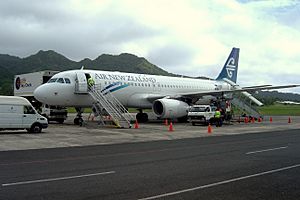
From 1989 Onwards
New Owners and Stock Market
In October 1989, Air New Zealand became a private company again. It was sold to a group led by Brierley Investments Ltd. Brierley kept 65% of the shares. The rest were sold to the public, staff, and other investors. Qantas bought 19.9%, Japan Airlines 7.5%, and American Airlines 7.5%. The New Zealand Government kept a "Kiwi share." This special share makes sure that most of the airline is owned by New Zealanders. In the same year, Air New Zealand was listed on the New Zealand Stock Exchange.
Newer Aircraft and Routes
In early 1990, Air New Zealand received its first Boeing 747-400. This plane was so advanced that pilots and cabin crew needed new agreements for pay and long flight hours. The first flight finally happened in late 1990.
In 1991, the airline also received its first Boeing 767-300. This was a big improvement and added to the seven Boeing 767-200ERs already in use. The 767-300ER could fly further and carry more passengers. This allowed Air New Zealand to open new routes to Asia. It also increased flights on the trans-Pacific service. A second daily Los Angeles flight was added via Honolulu, and later a third via Rarotonga and Apia. The Boeing 767-300ERs were updated with winglets to make them even more efficient. While some Boeing 767s have been replaced by the Boeing 777-200ER, the Boeing 787-9 is set to replace the last ones from 2014.
New routes were added in the early 1990s:
- 1990: Kuala Lumpur, Denpasar, Bangkok
- 1991: Nagoya, Taipei
- 1993: Seoul
- 1994: Sydney – Los Angeles, Osaka
- 1995: Fukuoka
Focus on Australia
After Australia made its domestic air market more open in 1990, the government said New Zealand airlines could fly unlimited services there. Air New Zealand immediately planned many flights between major Australian cities. However, at the last minute, the Australian Transport Minister changed the plan. Air New Zealand was allowed more international flights from Australia, but not domestic flights within Australia. This led Air New Zealand to look for other ways to grow in Australia. This is why they decided to buy Ansett Australia.
Growing the Airline
In 1995, Air New Zealand added Fukuoka to its Japanese destinations. It also announced plans to buy 50% of Ansett Airlines. Ansett was a much larger company than Air New Zealand. It held almost half of the big Australian domestic market but had been struggling for years. Experts said Ansett needed a lot of money to fix its problems and update its old planes.
For Air New Zealand, buying half of Ansett was a way to get into the profitable Australian domestic market. The deal was complex. Air New Zealand had to sell its own competitor in New Zealand, Ansett New Zealand. It also had to sell most of Ansett International to Australian investors. This was to meet rules in both countries. Air New Zealand paid A$475 million for half of Ansett, including A$150 million to help Ansett's finances. The deal was completed on October 1, 1996.
A new low-cost airline called Freedom Air started in 1996. In 1997, flights to South Korea were stopped due to money problems in Asia. Air New Zealand also formed a small partnership with United Airlines. In 1998, EVA Air and Air New Zealand started flying Boeing 767s together between Taipei and Auckland. Air New Zealand also received three new Boeing 737-300s for flights between New Zealand and Australia.
During 1998, the company began selling its five Boeing 747-200 aircraft to Virgin Atlantic. These were all sold by 2000. In 1998, Air New Zealand also announced plans to join the Star Alliance in 1999.
By 1999, all five weekly flights to Tokyo were flown by Boeing 747-400s. Air New Zealand and United also asked for special permission from the US government for their alliance agreements.
Challenges and Changes
In March 1999, Ansett and Air New Zealand became full members of the Star Alliance. This time also saw a long and confusing struggle over who owned Ansett. Ansett was still making a profit, but it needed a lot of money to replace its old planes. Neither of its owners, News Limited nor Air New Zealand, had enough money to spare.
Many airlines, like Singapore Airlines (SIA) and Qantas, showed interest in buying Air New Zealand. Ansett employees even planned to buy the company themselves. In March 1999, SIA offered A$500 million for half of Ansett. Experts thought this was a great idea because SIA was a very successful airline. However, Air New Zealand had the first right to buy News Limited's half of Ansett if it matched other offers.
The Air New Zealand board eventually approved the sale to SIA. But talks stopped when a major Air New Zealand shareholder tried to get SIA to buy Ansett through Air New Zealand. In June, News Limited withdrew its offer to sell.
Ansett then announced a surprisingly high profit of A$149 million. News Limited used this to ask for A$1 billion for its half. But experts thought this was too much, saying the true value was no more than A$700 million.
In February 2000, Air New Zealand announced it would buy the remaining half of Ansett for A$680 million. Many experts believed this was a bad decision. They thought the price was too high, and Air New Zealand wouldn't be able to afford the needed plane updates. One expert said, "by taking it on, they ensured that their own airline was in terrible danger. That was a dreadful mistake."
Gary Toomey became the new CEO of both Air New Zealand and Ansett Holdings in December 2000. Some flights, like those to Frankfurt and some from Los Angeles, were stopped. Other Star Alliance partners like Lufthansa and United took over these routes.
In 2001, Air New Zealand planned to buy 16 new Beechcraft 1900D planes. These would replace older planes that served smaller airports.
Ansett's Difficulties
Ansett was in bad shape. Its 767 planes were old and not well maintained. In December 2000, the Australian aviation authority grounded seven of Ansett's planes for inspections. In April 2001, just before a busy holiday, all 10 Ansett 767s were grounded again due to safety issues. Ansett was even threatened with losing its flying license.
To help, Air New Zealand lent Ansett a Boeing 767 and a Boeing 747. Other airlines also helped. Singapore Airlines, which owned 25% of Air New Zealand, agreed to help fix Ansett's planes.
Despite public concern, CEO Gary Toomey said the groundings only cost NZ$5.2 million. He announced that the seven oldest Ansett Boeing 767s would be sold, along with three of Air New Zealand's 767s. Newer planes would be rented instead. Toomey said this showed the need to update the fleet and grow.
However, the reality was different. Both Air New Zealand and Ansett were barely making a profit. They needed a lot of money that neither could provide. Larger airlines like Qantas and SIA offered to buy the Air New Zealand group. But they needed special permission to own more than 25% of a foreign airline. The New Zealand government did not want to make a decision.
Meanwhile, Air New Zealand's money problems grew. Ansett was losing customers to Qantas and a new airline, Virgin Blue. The Air New Zealand board decided to buy Virgin Blue as well. If that deal happened, SIA was ready to fund 32 new planes for the group. But Virgin Blue was growing fast. Its owner, Sir Richard Branson, famously tore up what he claimed was an Air New Zealand cheque on TV, ending negotiations.
On September 10, 2001, Air New Zealand desperately offered to sell Ansett to Qantas for $1. After two days, Qantas said no. Air New Zealand then stopped trading its shares and put Ansett into administration. Ansett was bankrupt, and Air New Zealand was in almost as bad a state. The next day, Air New Zealand announced a huge loss of NZ$1,425 million. Most of this was from Ansett's value being written off.
There was a lot of public anger in both New Zealand and Australia. People asked how such big losses were possible. Air New Zealand denied taking money or parts from Ansett at the last minute. Ansett's administrators later confirmed this was true.
The anger was so strong that New Zealand Prime Minister Helen Clark's plane was blocked by laid-off Ansett workers at Melbourne airport. An RNZAF Orion plane had to be sent to pick her up.
Later, it became clear that the New Zealand Government had asked the Australian Government not to take legal action against Air New Zealand. They said it would hurt those who had money claims against the company. The Australian government said this pressure did not affect its decisions.
Laid-off Ansett workers eventually received most of their payments. This came partly from a NZ$150 million payment from Air New Zealand. Most of it came from a A$10-per-seat fee that the Australian government put on airline tickets.
A New Start
In October 2001, the New Zealand Government announced it would give Air New Zealand NZ$885 million to save it. In return, the government would own 80% of the airline. Gary Toomey resigned as CEO that same month.
In early 2002, Ralph Norris became the new CEO. He faced the tough job of bringing the airline back to life.
In mid-2002, Air New Zealand decided to change its domestic flights. It became a lower-cost airline. This meant no business class and no meals on most domestic flights. The airline said that travelers preferred to save money on tickets than pay extra for a meal. The company also made online sales its main way of selling tickets. It stopped paying travel agents and added fees for phone or counter sales. This approach was very successful. Online bookings greatly increased, and domestic bookings grew by 23%. In July 2002, the airline ordered 15 Airbus A320-200 aircraft. These would replace Boeing 737-300 and Boeing 767-200 planes used on Tasman routes. Five would be bought, and ten would be leased.
In late 2002, the New Zealand Government agreed to let Qantas buy a 22.5% share for NZ$550 million. But this plan was blocked by regulators in both Australia and New Zealand. They said it would reduce competition. Despite this, Air New Zealand and Qantas said they would try to appeal the decisions.
In November 2003, Air New Zealand expanded its successful low-cost "Express" idea to flights across the Tasman Sea. This also proved successful, with bookings increasing by about 10% in the first few months. On June 30, 2004, the airline started non-stop flights from Auckland to San Francisco. This was the first new international destination in eight years. In September 2004, Air New Zealand was named "Best Long Haul Airline" by Conde Nast Traveller UK.
On September 20, 2004, the New Zealand High Court blocked Qantas' plan to buy shares in Air New Zealand. Both airlines decided not to appeal. However, they said they would look for other ways to work together. In October 2004, SIA sold its remaining shares in Air New Zealand.
Air New Zealand started its first flights to mainland China in November 2006, with a route from Auckland to Shanghai. Following that success, Beijing was added on July 18, 2008, though this route ended in July 2012. Flights to Bali restarted on June 20, 2012. Seasonal flights to Sunshine Coast began on July 1, 2012. This made Air New Zealand the first overseas airline to fly into four cities in the Australian state of Queensland.
Air New Zealand stopped flights to Oamaru on January 1, 2010. Wanaka lost its only air service when Air New Zealand ended its link from Christchurch on January 31, 2013. However, seasonal non-stop flights from Perth to Christchurch resumed on December 4, 2013. Air New Zealand also expanded its international services again. Flights to Singapore resumed, and new routes to Houston and Buenos Aires began in December.
Earthquake Emergency Flights
On February 22, 2011, at 12:51 pm, New Zealand's second-largest city, Christchurch, was hit by a 6.3 magnitude earthquake. This caused many deaths and a lot of damage.
Christchurch International Airport was immediately closed for 18 hours. This allowed airport staff to check the runway. Only urgent medical and rescue flights were allowed. Once cleared, the airport opened for international aid flights. Air New Zealand brought in all its available planes to fly stranded tourists and people needing to leave out of the damaged city. The airline also offered $50 airfares to help everyone leave. Some domestic flights to Auckland were flown by large planes like the Boeing 747-400, Boeing 777-200ER, and the new Boeing 777-300ER. Wellington saw Boeing 777-200ER and Boeing 767-300s, planes not usually seen there. Smaller airports also received larger jet planes than usual.
Images for kids


